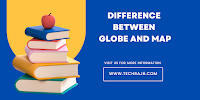Globes and maps are tools used to represent the Earth's surface, but they have distinct differences in terms of format, use, accuracy, and representation. Here are the key differences between globes and maps:
### Definition
- **Globe**:
- A three-dimensional, spherical model of the Earth that accurately represents its shape, geographical features, and relative distances.
- Provides a realistic view of the Earth as a whole, showing the correct proportions and spatial relationships.
- **Map**:
- A two-dimensional, flat representation of the Earth's surface or a portion of it.
- Can depict various scales, areas, and themes (e.g., political boundaries, physical features, climate, population).
### Representation
- **Globe**:
- Shows the Earth in its true spherical shape, providing an accurate depiction of continents, oceans, and distances.
- Maintains the correct relative size and position of geographical features without distortion.
- **Map**:
- Represents the Earth's surface on a flat plane, which requires the use of projections that can introduce distortions in shape, size, distance, or direction.
- Different types of maps (e.g., Mercator, Robinson, Winkel Tripel) are used to minimize specific distortions based on the map's purpose.
### Scale and Detail
- **Globe**:
- Limited scale and detail due to its three-dimensional nature and practical size constraints.
- Useful for general reference and understanding global relationships but not for detailed local information.
- **Map**:
- Can be produced at various scales, from large-scale maps (detailed, showing small areas) to small-scale maps (less detailed, showing large areas).
- Allows for detailed representation of specific regions, cities, and thematic information.
### Portability and Usability
- **Globe**:
- Less portable and convenient due to its size and shape.
- Not practical for carrying around or using in the field but excellent for classroom settings and general education.
- **Map**:
- Highly portable, can be folded, rolled, or stored digitally.
- Practical for everyday use, navigation, planning, and fieldwork.
### Practical Applications
- **Globe**:
- Ideal for teaching and visualizing global geography, understanding the Earth's rotation and tilt, and demonstrating the relationships between different parts of the world.
- Often used in educational settings to provide a realistic view of the Earth.
- **Map**:
- Versatile for various applications, including navigation, urban planning, resource management, and thematic analysis (e.g., climate maps, population density maps).
- Widely used in everyday life, from road maps and atlases to digital maps on smartphones and GPS devices.
### Distortions
- **Globe**:
- No distortions in shape, size, distance, or direction since it accurately represents the Earth's curvature.
- **Map**:
- Subject to distortions due to the projection method used to flatten the Earth's surface.
- Different projections balance these distortions differently, with some preserving shape (e.g., conformal maps) and others preserving area (e.g., equal-area maps).
### Key Points
- **Globe**:
- Three-dimensional, spherical representation.
- Accurate depiction of shape, size, and distances.
- Limited detail and less portable.
- Ideal for understanding global relationships and Earth's true shape.
- **Map**:
- Two-dimensional, flat representation.
- Subject to distortions but can vary in scale and detail.
- Highly portable and versatile.
- Useful for detailed, specific information and various practical applications.
Understanding these differences can help in choosing the appropriate tool for educational purposes, navigation, planning, and other geographical analyses.

